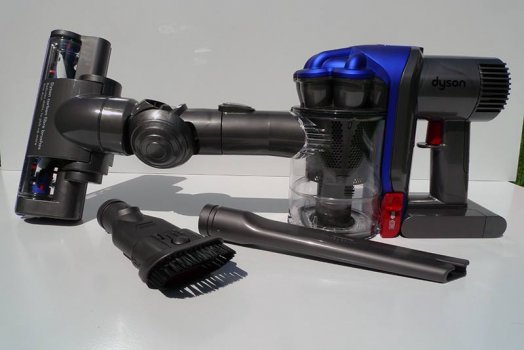 While the mundane household chore of vacuuming will always be, well.. mundane, it took on a slightly more digital nature of late as we got around to reviewing the Dyson Digital Slim DC35 Handstick.
While the mundane household chore of vacuuming will always be, well.. mundane, it took on a slightly more digital nature of late as we got around to reviewing the Dyson Digital Slim DC35 Handstick.
With plenty of carpet, tiles or wooden flooring – and one ever clumsy reviewer – testing the DC35 would prove to be as interesting as it was handy.
Read on read our DC35 review – and please do try to appreciate our deft avoidance of an almost limitless supply of double entendres.
FIRST IMPRESSIONS
Inside the carefully packed and compartmentalised DC35 box we found a mostly disassembled DC35. The unit consists mainly of the Radix Cyclone and Digital Motor assembly attached to a small removable dust bin which at the other end is attached to a long reach wand and three handy head (tool) accessories: A motorised cleaning head, a crevice tool and the always useful combination tool. Also included was a Lithium ION battery good for around 15 minutes of vacuuming, a charger and a small wall mountable docking station. Finally, a short manual/registration form rounded out the package.
The three replaceable tools looked well made and durable. The motorised floor tool was clearly the leader of the pack and featured two separate sets of brushes which engaged automatically depending on the type of flooring being vacuumed: “Ultra-fine conductive carbon fibre” brushes went in to battle for hard floors while rotating nylon brushes engaged in carpet sorties.
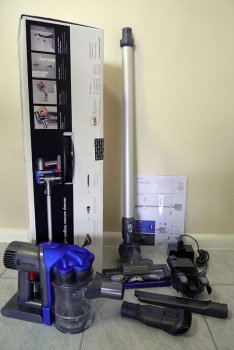
At 0.35 litres, the included dust bin assembly looked and was very compact. In fact, the entire unit’s strange proportions (1120 x 230 x 300mm with wand attached) made the DC35s main motor unit look almost farcical. On its own, the main unit’s 2.25kg weight felt just about right in the hand for flooring but with the wand and motorised floor tool attached, might be considered a little on the heavy side if used overhead. For regular flooring/furniture work however, the unit’s weight made it feel solid and surprisingly weapon like.
While it’s all pretty esoteric, Dyson’s unique Radix Cyclone and Digital Motor Assembly features technology that promises zero suction loss as you vacuum. This voodoo magic has something to do with the digital motor creating a “power efficient vacuum” due to its “spinning three times faster than a conventional motor”. Okay, then.
Coupled with the promise of no ongoing filter costs and the unit’s suitability to “all floor types,” the DC35 looks the goods on paper.
And of course it goes (almost) without saying that emphasising the technical voodoo, the DC35 (like every Dyson’s we have ever seen) abounds in that straight out of Minority Report look and feel we can’t get enough of.
USAGE
Having taken a brief look at the mostly graphic operating manual, we connected the DC35’s battery for the three and a half hour suggested charging time. While the battery charged we noticed that the unit and battery pack had been designed in such a way as to allow the battery to be charged both while it was connected to the unit or on its own at a remote location. While this might sound trivial, we found that it allowed us to display the wall mounted DC35 in all its futuristic glory, while the very unfuturistic cabling stayed out of sight doing the dirty work.
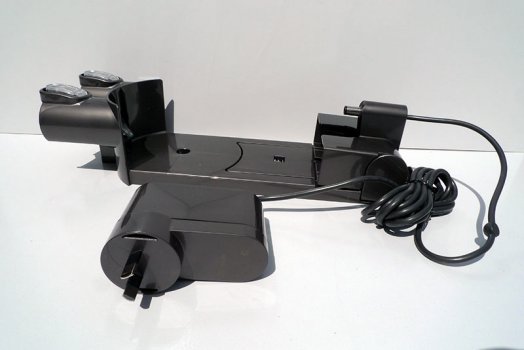
Once the unit was fully charged, we clicked the mag.. err, battery into the unit and we were ready to rock ‘n’ roll.
Over the next few weeks we took to using the DC35 for odd jobs around the house and it quickly became the vacuum of choice for small clean up jobs. On all flooring we found it sucked effortlessly and lived up to its “no loss of suction” claims, even when dealing with copious amounts of dust and dirt. While the crevice tool worked wonders in between car seats and small nooks and crannies, the motorised head tool worked like a gem in lifting debris from carpet, wood and tiled floors.
As for the tools themselves, we were impressed by their overall quality and workmanship. The motorised floor tool’s strange looking pivot head was a clear highlight whose clever design allowed the tool to turn around corners without losing contact with the floor. The velour bumpers found on the motorised floor tool also did a great job of protecting furniture and wall skirting – particularly when we were pressed for time.
And speaking of being in a hurry.. When you are pressed for time, Dyson have cunningly included a MAX button for you to, well.. press. Once depressed, the MAX mode button on the DC35 delivers a power boost for quick action on difficult tasks. We don’t have any suction figures to differentiate between MAX and regular mode but coupled with an increased noise, a lit up MAX button and a slashing of operational time to only 6 minutes you couldn’t help but think that in MAX mode the DC35 was doing a little bit more.
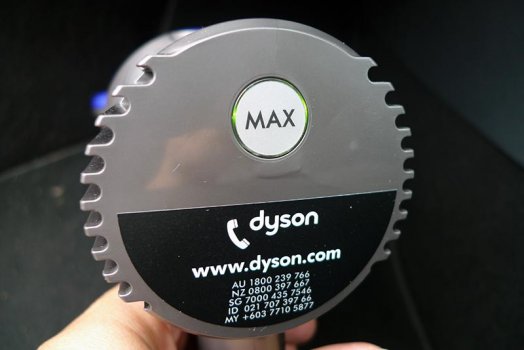
In general testing, we mainly used the unit in regular (non MAX) mode with the motorised floor tool on various surfuaces and got a maximum of 17 minutes out of a single charge. While this varied somewhat depending on use, load and flooring, we never got less than 14 minutes of continuous cleaning out of the DC35’s battery. MAX mode battery life was similarly up to spec with no less than five and a bit minutes of hardcore dirt removal on a single charge.
When we approached the end of the DC35’s charged battery life, the unit’s green LED (located on the top rear of the unit) began to flash once per second. When nearing the limit of usage in MAX mode, the MAX mode button flashed along with the warning LED. We found the warning very helpful and in regular mode, found that we got about 60 seconds of use once given the initial warning message.
At the end of a cleaning session, the dust and dirt was dumped straight into the garbage by firmly pressing on the one-touch bin emptying lever. Actually cleaning the DC35 was also straight forward with its mainly plastic construction coming back apart as needed.
The filter (which is designed to last at least as long as the unit itself) is easily maintained via regular washing under cold water. The dust bin, tools and main unit would get by with only a cursory wipe down with a dry cloth.
Removing hairs and debris from the motorised head was also less painful than expected. By turning a small screw anti-clockwise on the motorised floor tool, the brush shaft could be removed and cleaned as needed. All pretty easy, really.
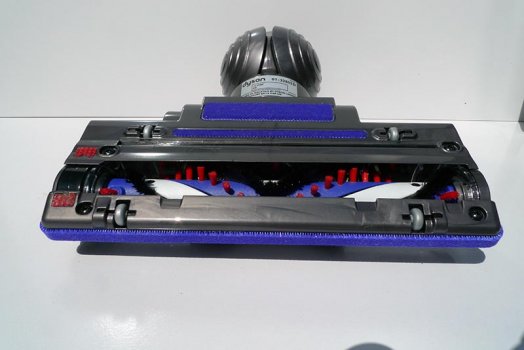
While we have used hand held vacuum cleaners before, what set this one apart was its lightweight long-reach wand. Coupled with the unit’s relatively light weight, the wand allowed us to effectively use the DC35 as a regular vacuum cleaner, albeit for short bursts. Cornices and other hard to reach areas became easily accessible and unlike similar products, constant bending was reduced significantly. The inclusion of the three accessory tools afforded the unit great flexibility. The crevice tool was excellent for cleaning small awkward areas while the combination accessory proved great for general dusting.
Not only did the DC35 prove to be handy for small jobs, on the whole it cleaned at least as well as our large whole house vacuum cleaner. And without the need for bags or replacement filters, the DC35 ended up pretty much embarrassing our long standing household vacuum cleaner.
Of course, even discounting our praise for its futuristic design, the DC35 was clearly never meant to be a full replacement for a large scale vacuum cleaner. It’s convenience and size did replace it for the isolated large cleanups but for smaller jobs, it showed its real worth and effectively relegated the dustpan and brush to the laundry cupboard.
It is also worth noting that throughout our testing, we never experienced any sort of loss of suction. Even after the dust bin began to look full, the suction remained steady. Even in MAX power mode, the unit did its thing at full pelt until it was spent.
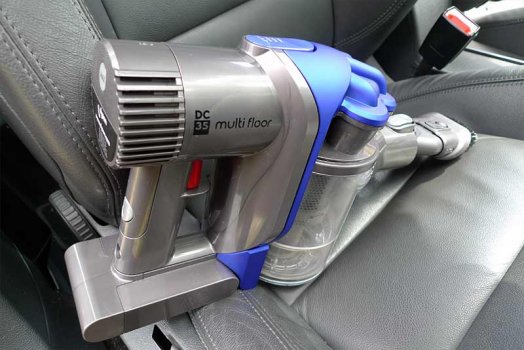
While our overall experience with testing the DC35 was good, we did have one minor quibble: The trigger – To operate the unit, the trigger on the DC35 has to be constantly depressed in that if you let go or otherwise let your finger slip, the DC35 will stop sucking. While we actually felt this to be somewhat intuitive to us due to its gun shape, this trigger implementation may be considered a issue to some.
CONCLUSION
Firstly, it was really great to see all three head attachments included in the package as opposed to making them add-on purchases. All three included tools were excellent for their respective purposes and really made the DC35 package feel complete.
Along with a two year guarantee, the DC35 comes with free access to a 7 days a week helpline although we wonder exactly who would need it as this device is dead simple to use, even if you skip the brilliantly graphic operating manual.
And while we have cunningly avoided any crass metaphors – just – like Wikileaks, we do feel we have a civic duty to disclose the large scale conspiracy we uncovered during the course of our review.
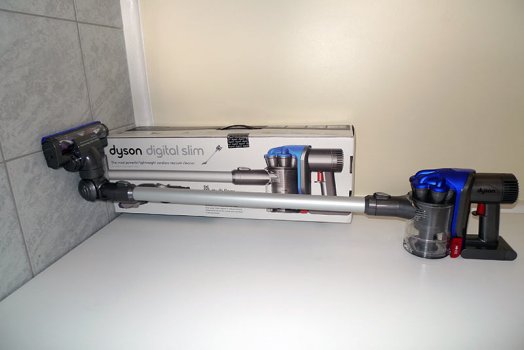
The DC35 is more than just a handy small job vacuum cleaner. With its futuristic sci-fi good looks; gun like shape; carbon fibre brushes; a maximum of 15 minutes vacuuming time; incredibly simple ease of use and a turbo.. err, MAX power button, the DC35 is clearly an underhanded and sneaky attempt by the Dyson people to cajole men into doing the vacuuming.
And I think it’s working.
The Dyson DC35 is available through various Australian retailers and has a recommended retail price of $469AU. For more information hit the Dyson website.
9.5/10


